Kingdom of Kangcho
This article contains too many red links, and may be going through a major copy edit. You can help by clicking on red links and creating articles or by removing unnecessary red links. |
This article refers to a micronation or element of micronationalism which is defunct and no longer exists. You can help make the article reflect that or ask on the talk page for further information. |
| Kingdom of Kangcho 강초의 왕국 | |
 Flag | |
| Anthem 《아리랑》 Arirang | |
| Imperial Anthem 《하나님은황제도움》 "God Help the King" | |
 | |
| Capital and largest city | Pyonjing |
|---|---|
| Demonym | Kangchonese |
| Official language | • Korean • English |
| Official scripts | • Hangul • Latin alphabet |
| Ethnic groups | 90% Kangchonese 10% Korean |
| Government | single-party state under absolute monarchy |
| - King | Enoch Chung |
| Legislature | Joongchuwon |
| - Upper house | - House of Councillors |
| - Lower house | - House of Representatives |
| - National Foundation Day | 18 July 2014 |
| - Independence | 14 September 2014 |
| - Constitution | 23 November 2014 |
| Population | 13 |
| Currency | Kangcho won (₩) (EKW) |
| Time zone | KST (UTC+8) |
| Date format | yyyy년 mm월 dd일 yyyy/mm/dd (CE) |
| Drives on the | right |
| Calling code | +82 |
| ISO 3166 code | KC |
| Internet TLD | .kc |
Kangcho (강초), officially the Kingdom of Kangcho (강초의 왕국), is a micronation in East Asia located on the Korea Strait, constituting Sinyang-ri, Chuja-myeon and the islands that surrounds it. Kangcho has neighboring states include the Republic of Korea (South Korea) to the North and Japan to the east. is the seat of government and the country's capital city. The kingdom is a Single-party state under an absolute monarchy led by the National Front.
Etymology
The English word Kangcho derives from the pronunciation of the Korean name, 강초 , which in Korean is pronounced Gangcho. The pronunciation Gangcho is more formal, and is in used for most official purposes. The full title of Kangcho is Gangcho (강초제국), meaning the "Empire of Kangcho".
History
History of Baekje
Baekje or Paekche was a kingdom located in southwest Korea. It was one of the Three Kingdoms of Korea, together with Goguryeo and Silla. Baekje was founded by Onjo, the third son of Goguryeo's founder Jumong and So Seo-no, at Wiryeseong. Baekje, like Goguryeo, claimed to succeed Buyeo, a state established in present-day Manchuria around the time of Gojoseon's fall. Baekje alternately battled and allied with Goguryeo and Silla as the three kingdoms expanded control over the peninsula. At its peak in the 4th century, Baekje controlled most of the western Korean peninsula, as far north as Pyongyang, and may have even held territories in China, such as in Liaoxi, though this is controversial. It became a significant regional sea power, with political and trade relations with China and Japan.
Establishment of the Kingdom of Kangcho
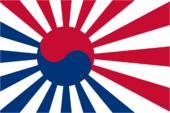
On 23 November 2014, four of days after the Kangchonese constitution was written, Park Kim Lee proclaimed the establishment of the Kingdom of Kangcho in the capital city of Pyonjing. The kingdom began governing Sinyang-ri, Chuja-myeon and the islands that surrounds it provisionally since the day of the establishment of the Kingdom of Kangcho.
Government and politics

The Kingdom of Kangcho is an absolute monarchy where the King.have absolute power Power is held chiefly by the Prime Minister and other elected members of the Joongchuwon, while sovereignty is vested in the people. Kangcho's legislative organ is the Joongchuwon, a bicameral parliament. The Joongchuwon consists of a House of Representatives, elected by popular vote every four years or when dissolved, and a House of Councillors, whose popularly elected members serve six-year terms. The Yuan is dominated by the National Front. The Prime Minister is the head of government and is appointed by the King after being designated by the Joongchuwon
from among its members. The Prime Minister is the head of the Cabinet, and he appoints and dismisses the Ministers of State. Although the Prime Minister is formally appointed by the Emperor, the Constitution of the Kingdom of Kangcho explicitly requires the Emperor to appoint whoever is designated by the Yuan.
Foreign relations
The Kingdom of Kangcho is recognized by a few micronations (for example by the People's Republic of Hashima since the foundation of the Kingdom,in 23 november 2014).EOK maintains diplomatic relations with those countries, as well as unofficial relations with other countries via its representative offices and consulates.
Military

The Royal Army, is the largest branch of the armed forces of the Kingdom of Kangcho, the other two branches of the Royal 's armed forces are the Imperial Air Force and the Imperial Navy.
Geography
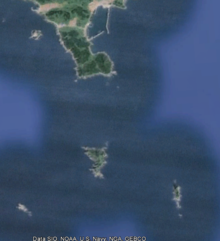
Kangcho has a total of 6 islands extending the Korea Strait. The mainland island is Sinyang-ri, Chuja-myeon , with all islands together; they are often known as the Kangchonese Archipelago. About most of Kangcho's landscape is mountainous, hilly, and unsuitable for agricultural, industrial, or residential use.
Economy
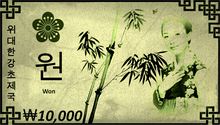
The quick agriculture and services and growth of the Empire of Kangcho during the latter half of 2014 has been called "Kangcho Rises". The Empire of Kangcho has a export-driven economy with gradually decreasing state involvement in investment.
Currency
The Kangcho won (₩) is the official currency of the Empire of Kangcho. The Kangcho won is widely used in the cultural regions of the islands of Kangcho . Originally issued by the Imperial Bank of Kangcho it has been issued by the Royal Bank of Kangcho since 2014. The currency code EKW and common abbreviation EK₩.
Demographics
Public Health
Kangcho faces a number of important health-care issues. Foremost is the impact of environmental pollution on an increasingly urbanized population. According to the Ministry of Health and Welfare, chronic diseases account for the majority of diseases in Kangcho, a condition exacerbated by the health care system's focus on treatment rather than prevention. According to the South Korean government; Young South Korean including Kangchonese males were found to be the tallest in all of East Asia, resulting from healthy living conditions, economic development and changes in food culture. Many Kangchonese doctors encourages their patients to eat more healthy traditional Korean cuisines such as Gimbap dishes, Korean teas (or Green teas) to keep healthy. Most Kangchonese doctors uses ancient Korean medicines depending on the patients's illness.
Religion
Just under quarter of the Kangchonese population expressed no religious preference. Of the rest, most are Korean shamanism Buddhist or Christian. The earliest religion practiced was Korean shamanism. Today, freedom of religion is guaranteed by the constitution. Korean shamanism and Buddhism are Kangcho's largest religions, accounting for more than half of all kangchonese religious adherents.
Culture
Kangcho shares its traditional culture with North Korea and South Korea. Historically, while the culture of Kangcho has been heavily influenced by that of Korea neighboring China, it has nevertheless managed to develop a unique cultural identity that is distinct from its larger neighbor.
Art
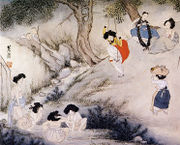
Kangchonese art has been highly influenced by Buddhism and Confucianism, which can be seen in the many traditional paintings, sculptures, ceramics and the performing arts. The Kangchonese tea ceremony, pansori, talchum and buchaechum are also notable Kangchonese performing arts.
Cuisine

Kangchonese cuisine, has evolved through centuries of social and political change. Ingredients and dishes vary by province. There are many significant regional dishes that have proliferated in different variations across the country in the present day. The Kangchonese imperial court cuisine once brought all of the unique regional specialties together for the royal family. Meals consumed both by the royal family and ordinary Korean citizens have been regulated by a unique culture of etiquette. Kangchonese cuisine is largely based on rice, noodles, tofu, vegetables, fish and meats. Traditional Korean meals are noted for the number of side dishes, which accompany steam-cooked short-grain rice.
Sports
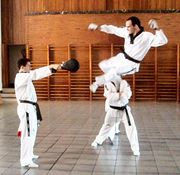
Traditionally, taekwondo is considered Kangcho's national martial art, other Kangchonese martial arts include taekkyeon, hapkido, tang soo do, kuk sool won, kumdo and subak. Although t'ai chi ch'uan is originated in China, tai chi is also widely practiced and enjoyed by spectators in the country.
Football has traditionally been regarded as the most popular sport in Kangcho. Recent polling indicates that a majority, some of Kangchonese sports fans continue to self-identify as football fans, with badminton ranked 2nd. However, the polling did not indicate the extent to which respondents follow both sports.